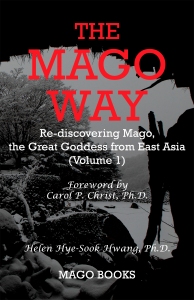 The Mago Way: Re-discovering Mago, the Great Goddess from East Asia
The Mago Way: Re-discovering Mago, the Great Goddess from East Asia
Authored by Helen Hye-Sook Hwang, Ph.D.
- Publisher: Mago Books (October 3, 2015)
- Paperback: 244 pages
- Language: English
-
ISBN-13: 978-1516907922
-
ISBN-10: 1516907922
-
BISAC Category: Body, Mind & Spirit / Shamanism
- Product Dimensions: 5.5″ x 8.5″ (13.97 x 21.59 cm)
Available at Mago Bookstore (http://magobooks.com) and Amazon (www.amazon.com).
In The Mago Way: Re-discovering Mago, the Great Goddess from East Asia, I have shared my personal, scholarly, and spiritual discoveries concerning the Great Goddess known as Mago in East Asia. Comprising eight essays researched, some published, between 2000 and 2015, this book is a crystallization of my feminist intellectual/spiritual/activist endeavor (1) to search for my own East Asian/Korean gynocentric cultural and historical background; (2) to dis-cover the overall features of Magoism, the mytho-historical-thealogical matrix that venerates Mago as the supreme divine; (3) to reinstate the pre- and proto-patriarchal mytho-history of Magoism from the perspective of Old Korea; (4) to assess cross-cultural parallels with worldwide Goddess traditions; and (5) to delineate the metamorphic nature of the Magoist Cosmogony. Due to the complexity of the Magoist Cosmogony, however, Volume 1 can only treat the first part, which is prior to the self-evolution of Mago Stronghold (Earth).
Eliciting the Reality of the whole, the Magoist Cosmogony tells us that HER Beginning is not a thing of the bygone past but the Work of WE/HERE/NOW. The ultimate agent, time, and space are the unified One. It informs us that the natural process of autogenesis takes place as the universe reaches HER sonic equilibrium. All things are self-born through the sonic movement of the universe. Mago too has come into being through the very music of Eight Tones, also known as “the music of the spheres” in the West.
Surviving unbridled by patriarchal censorship over the course of time, the Mago Cosmogony redefines the Holy Text as necessarily gynocentric. It awakens a deep knowing in us. It may be called a vision in that it is about dis-covering truth, to be precise, the gynocentric nature of Reality. The symbol of the Female (S/HE) is not a sex indicator. Encompassing the All, the Female is the Way of the Universe. I intend to use “sex” in place of “gender” in this book. First of all, the context (the Divine Realm of the Great Goddess) is prior to the bifurcation of the sexes. Thus, the notion of gender for “the Female” is irrelevant. Secondly, it is to restore the discussion of “sex” in place of “gender” for feminist discourse. “Sex” is the original factor that precedes and gives rise to the notion of “gender.” It is the biological nature of women and men that Magoist Feminism concerns, as it seeks the empowerment of “the female” rather than “the feminine” and the balance between “sexes” rather than “genders” across time and space.
This book reflects the flow and evolution of my intellectual/spiritual/physical journey toward the Great Goddess. Although Chapters 2, 3, 4, 5, 6, and 7 of this book have been previously published in anthologies and journals, they are not exactly the same as the original essays. I have rewritten Chapters Four and Six to a significant extent to align with up-to-date insights that I have newly included in Chapters One and Eight. For other chapters, I have made necessary changes in the body and endnotes so that they, while upgraded to the newest insight, remain as milestones to their original versions. Figures (24 in all) are included to aid visual orientations. I have created the Glossary for key concepts, after standardizing the romanizations and translations of East Asian words. It is my hope that this book comes to you as a revelation, as it does to me.
